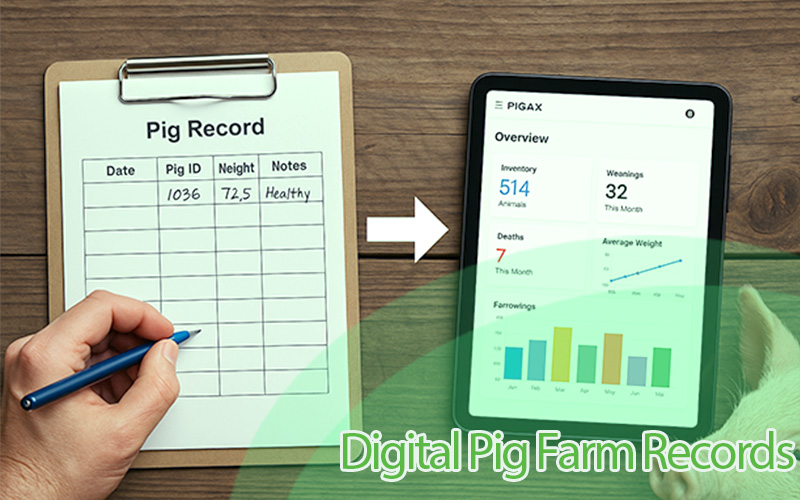5 pig management practices that boosts efficiency in your farm
Pig farmers suffer a lot of uncertainties like disease outbreaks, poor growth, and mortalities that would have been easily prevented had they had a management plan. On average 50% of pig farms close up because of poor planning and lack of management plan for the entire piggery operation. Pig management is one of the four pillars of pig farming alongside genetics, nutrition, and health that is responsible for the success of every pig farming operation. In short, no piggery business can succeed without adopting good management practices
What is pig management practice?
Pig management practices refer to the various techniques and strategies that pig farmers put in place to ensure that the pigs on the farm perform efficiently and yield the expected financial results. This calls for proactiveness on the part of a pig farmer. A professional pig farmer must be aware of all the usual upcoming events in the farm operation, then prepare strategies to carry them out effectively. These events may include, mating, heat, feed change, farrowing and weaning, vaccinations e.t.c
These practices are important for the health and well-being of the pigs, as well as for the overall success of the farming operation and they include
1. Feed Management Practices
About 70% of the total production cost of the pig farm is due to the feed cost. This is because the growth and development of the pigs largely depend on their feeding routine. The pig is the most efficient animal in converting feed to meat. Some of the feed management practices include
-
Flushing: This is a practice that involves increasing the feed ratio to sows and gilts seven to ten days before breeding to increase their ovulation rate to enhance litter size.
-
Creep feeding: The practice of self-feeding concentrates on young piglets in a separate enclosure away from their mother while they are still suckling is known as creep feeding. Creep feed should be given when piglets are two weeks old.
-
Feeding of pregnant sows: The demands resulting from pregnancy and the need for conserving nutrients for ensuing lactation are accelerated during the later stage of pregnancy. The increased needs are for proteins, vitamins, and minerals.
Other important areas in feed management include:
-
Nutrient requirements: Pigs have specific nutritional requirements that must be met in order to maintain optimal health and growth. Feed formulations should be tailored to the specific needs of the pigs, taking into account factors such as their age, weight, and production goals.
-
Feed storage and handling: Proper storage and handling of feed are important to maintain its quality and prevent contamination. This may include storing feed in a dry, well-ventilated area, and handling it with clean equipment.
-
Feeding frequency and quantity: Pigs should be fed at regular intervals, and the amount of feed provided should be based on their age, weight, and production goals. Overfeeding or underfeeding can have negative impacts on the pigs' health and productivity.
2. Environment and Temperature Management
This involves regulating the temperature of the pig pen to ensure the pig's optimal growth and development. Proper housing and environmental management are essential for the well-being and productivity of pigs. For example, Pigs are sensitive to high temperatures and can suffer from heat stress, which can lead to low feed intake. Cold temperatures can make pigs eat too much feed and grow less leading to a high cost of feeding with poor results.
Waste disposal is also an environmental managemental practice that requires attention. This process helps rid the farm of pig waste and dung and the waste disposal unit should be far from the pig pens to prevent pathogens from easily affecting the pigs.
3. Breeding Management
Selective breeding can be used to improve the genetics of a pig population, producing offspring with desired traits such as fast growth rate, high feed efficiency, and good meat quality. This can be achieved through the use of pedigree records, performance data, and other tools.
The following practices are relevant under this section of management
-
Keeping track heat of the sows and gilts which usually appear around every 20 days, non-return of heat after 20 days after mating means conception.
-
Monitoring the date of delivery for pregnant sows to prepare well in advance for farrowing and nursing of piglets.
4. Health Management
Certain measures must be adopted on the farm to manage diseases and health-related problems. These measures should mostly be proactive. Pig farmers must be aware of the common diseases and infections prone to affecting pigs. Here are some strategies that can help to manage the health of pigs on a farm
-
Biosecurity: This is a practice that is used to prevent the spread of diseases within a pig farming operation. These can include measures such as separating sick pigs from healthy ones, disinfecting equipment and facilities, and limiting the movement of people and animals in and out of the farm.
-
Vaccinations: vaccination and parasite control can help to prevent the onset of diseases and improve the overall health of the herd.
-
Monitor for signs of illness: Keep an eye out for signs of disease in your pigs, such as changes in appetite, behavior, or appearance, and take prompt action if you notice any changes. This can involve isolating sick pigs, administering treatment, and contacting a veterinarian if necessary.
5. Record keeping
By keeping accurate and up-to-date records, pig farmers can better understand the overall performance of their herd and make informed decisions to optimize the management of their farms. All of the four practices mentioned above can be useless without a good record-keeping system. A good management tool like pigax can help you track and monitor sows' heat, pregnancy, and farrowing activities to maintain optimum performance for your pig farm. Some of the benefits of keeping adequate records of the farm using the pigax management tool include
-
Availability of historical details (Age, Breed, gender) of each pig on the farm
-
Monitoring and tracking upcoming events like vaccinations, farrowing dates, and oestrus
-
Monitoring the cost of feeding consumed by individual pigs
Track fed levels in the farm




